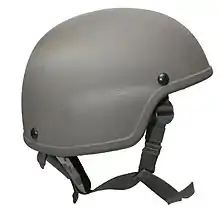Enhanced Combat Helmet (United States)
The Enhanced Combat Helmet (ECH) is a United States Army program to replace the combat helmets of the U.S. Army, Air Force, Navy, and Marines using thermoplastics instead of the ballistic fibers used on the current generation combat helmets.[2] The term "Enhanced Combat Helmet" was originally coined by Army Lieutenant Colonel William R. Schaffer. It is planned to be succeeded by the Integrated Head Protection System.
| Enhanced Combat Helmet | |
|---|---|
 An early ECH prototype; the production model uses a slightly different chinstrap. | |
| Type | Combat helmet |
| Place of origin | United States |
| Service history | |
| In service | 2013–present |
| Used by | See Users |
| Production history | |
| Designed | 2007 |
| Manufacturer | Ceradyne[1] |
| Produced | March 2012 – present |
| Specifications | |
| Mass | 3.3 lbs |

Design
The ECH's profile is very similar to the Advanced Combat Helmet but is thicker;[3] they can be identified due to the different chinstrap they use compared to the ACH.
The ECH helmet's shell is made of an ultra-high-molecular-weight polyethylene material. It is required to provide 35% better protection against small-arms fire and fragmentation than the Advanced Combat Helmet. The helmet is also required to protect against certain rifle projectiles. The helmet is of the "tactical cut" type and thus offers less coverage but does enable better mobility. The helmet will be compatible with camouflage fabric helmet covers.[4] The replacement of the Advanced Combat Helmet with the Enhanced Combat Helmet has been likened to the transition from the HMMWV to the MRAP.[5]
The helmet has been shown nearly impenetrable to fragments fired by test guns. In a v50 test, guns were unable to attain the velocity required to get 50% of the fragments through a helmet. The helmet has exceeded the 35% ballistic improvement requirement.[5]
The helmet's design allows for the addition of devices such as communications and night-vision equipment.
The Army is planning on using the existing pads used on the Advanced Combat Helmet for the ECH. A single pad that cushions the entire helmet may be developed. The ECH has a 4-point chinstrap/napestrap head retention system. The Marine/Navy and Army variants are differentiated in that the Marine/Navy version uses an X-Back retention system (called the Class I) and the Army uses the H-Back retention system (called the Class II).[4]
Development
In an effort led by the U.S. Army Research Laboratory,[6] ECH development began in 2007 under the Army Manufacturing Technology (ManTech) Program. Solicitations were accepted in late April until early June 2009. In July, more than $8 million was awarded to four vendors for five helmet designs in July 2009. Mine Safety Appliances was awarded $4.7 million, Gentex Corporation was awarded $1.8 million, BAE Systems Aerospace & Defense Group was awarded $764,000, and 3M subsidiary Ceradyne was awarded $729,000. Testing in September revealed that each helmet failed in ballistic and/or blunt force tests. In February 2010 the Navy joined the program and issued their own requirements. Marine Corps officials suggested design improvements such as better materials to industry and testing resumed in June 2010. Three vendors were to be downselected and the remaining two would be tested in November. If the program proceeded as planned the Army would acquire 200,000, the Marine Corps would acquire 38,500, and the Navy would acquire 6,700.
Ceradyne won the competition to produce the Enhanced Combat Helmet in March 2012. On 16 July 2013, the U.S. Marine Corps ordered 3,850 helmets for deployed Marines, to be fielded before the end of 2013.[7] The Marine Corps plans to buy 77,000 helmets, enough to outfit a large contingent of deployed U.S. Marines.[8] When they return, they will be turned in. The Lightweight Helmet and Modular Integrated Communications Helmet will still be used for training and noncombat purposes. PEO Soldier also confirmed that the Army will field the helmet. Fielding was scheduled to begin after the start of FY 2014 on 1 October 2013.[9][10] The Marine Corps' ultimate goal is to issue the ECH to all 182,000 Marines.[11]
Prior to enhancements under ManTech, every ballistic helmet in the U.S. military used a thermoset-based combination of aramid fiber with a PVB-phenolic resin. Although there have been improvements in the aramid fibers, the material and processing technology in the Army Combat Helmet (ACH) had not changed in 30 years. The ManTech program focused on addressing technology barriers that inhibited a new class of improved ballistic materials, including new grades of Dyneema, Spectra, and thermoplastic coated aramids.[12]
The Army helmet fabrication goal was to develop an entirely new methodology for mass producing complex shapes and combining layers of different thermoplastic materials. During this time, ARL and partners created a new molding technology, which included a manufacturing process reducing labor by 40% and waste by 70%.[13]
Other helmets from the ManTech program are already in the field and used by the Green Berets, the Navy SEALS, and Special Operations Forces. These include the Future Assault Shell Technology (FAST) and MARITIME helmet. The FAST helmet offers 25% weight reduction, while the MARITIME helmet offers a 35% weight reduction. The helmet technology includes new manufacturing processes developed at ARL, in collaboration with U.S. Army Natick Soldier Research, Development And Engineering Center and Program Executive Office (PEO) Soldier.[13]
ARL and its partners received DoD’s Manufacturing Technology Program Achievement Award in 2009 for work on ECH.[13]
Users
 Philippines: Ceradyne awarded contract for 3,121 helmets on December 2017 with a submitted bid amount of Php 202,899,331.00 ($3916975.5 USD)[14] and for 11,084 helmets with a submitted bid amount of Php 720,471,084.00 ($13908708.19 USD) for the Philippine National Police.[15]
Philippines: Ceradyne awarded contract for 3,121 helmets on December 2017 with a submitted bid amount of Php 202,899,331.00 ($3916975.5 USD)[14] and for 11,084 helmets with a submitted bid amount of Php 720,471,084.00 ($13908708.19 USD) for the Philippine National Police.[15] United States: United States Marine Corps[16]
United States: United States Marine Corps[16]
See also
References
- "U.S. Government Order Totals 114,000 Enhanced Combat Helmets from 3M". 3M News | United States.
- Marine Corps Systems Command (2013-07-30). "Enhanced combat helmet heads to production". Marine Corps Systems Command. Archived from the original on 2013-12-07. Retrieved 2014-03-19.
- Matthew Cox & Dan Lamothe (1 September 2009). "Army's new plastic helmet tops Kevlar ACH". Army Times. Retrieved 30 September 2010.
- "Enhanced Combat Helmet" (PDF). July 2010. Archived from the original (PDF) on 18 January 2012. Retrieved 30 September 2010.
- Lance M. Bacon (2011-02-26). "Head of the class". Army Times. Retrieved 2011-02-26.
- "Low Cost Manufacturing of Materials for Improved Warfighter Protection". U.S. Department of Defense Manufacturing Technology Program. Department of Defense. Retrieved 21 June 2018.
- "Ceramic Enhanced Combat Helmets And Personal Armor". AZoM.com. October 4, 2013.
- "3M to Supply Enhanced Combat Helmets to United States Marine Corps". 3M News | United States.
- New combat helmets coming for deploying Marines Archived 2013-10-07 at the Wayback Machine - MarineCorpstimes.com, 29 July 2013
- Army, Marines to Field Better Ballistic Helmets - Military.com, 30 July 2013
- Corps Needs Cash to Field New Helmet to All Marines - Kitup.Military.com, 14 September 2016
- "DMC Achievement Award - DoD ManTech". www.dodmantech.com. Retrieved 2018-07-11.
- "New Tech for Better Helmets" (PDF).
- "Supply and Delivery of 3,121 units Enhanced Combat Helmet Level III (Lot 1) under Public Bidding No. PNP-17-39G". pnp.gov.ph.
- "Supply and Delivery of 11,084 units Enhanced Combat Helmet Level III (Lot 2) under Public Bidding No. PNP-17-40G, NHQ BAC". pnp.gov.ph.
- "Marine Corps to Issue Enhanced Combat Helmet to Every Marine". Military.com. June 12, 2017.
External links
 Media related to Enhanced Combat Helmet (United States) at Wikimedia Commons
Media related to Enhanced Combat Helmet (United States) at Wikimedia Commons